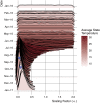Downgrading disease transmission risk estimates using terminal importations
- PMID: 31199809
- PMCID: PMC6594658
- DOI: 10.1371/journal.pntd.0007395
Downgrading disease transmission risk estimates using terminal importations
Abstract
As emerging and re-emerging infectious arboviruses like dengue, chikungunya, and Zika threaten new populations worldwide, officials scramble to assess local severity and transmissibility, with little to no epidemiological history to draw upon. Indirect estimates of risk from vector habitat suitability maps are prone to great uncertainty, while direct estimates from epidemiological data are only possible after cases accumulate and, given environmental constraints on arbovirus transmission, cannot be widely generalized beyond the focal region. Combining these complementary methods, we use disease importation and transmission data to improve the accuracy and precision of a priori ecological risk estimates. We demonstrate this approach by estimating the spatiotemporal risks of Zika virus transmission throughout Texas, a high-risk region in the southern United States. Our estimates are, on average, 80% lower than published ecological estimates-with only six of 254 Texas counties deemed capable of sustaining a Zika epidemic-and they are consistent with the number of autochthonous cases detected in 2017. Importantly our method provides a framework for model comparison, as our mechanistic understanding of arbovirus transmission continues to improve. Real-time updating of prior risk estimates as importations and outbreaks arise can thereby provide critical, early insight into local transmission risks as emerging arboviruses expand their global reach.
Conflict of interest statement
The authors have declared that no competing interests exist.
Figures




References
-
- Grills A, Morrison S, Nelson B, Miniota J, Watts A, Cetron MS. Projected Zika Virus Importation and Subsequent Ongoing Transmission after Travel to the 2016 Olympic and Paralympic Games—Country-Specific Assessment, July 2016. MMWR Morb Mortal Wkly Rep. 2016;65(28):711–715. 10.15585/mmwr.mm6528e1 - DOI - PubMed
Publication types
MeSH terms
Grants and funding
LinkOut - more resources
Full Text Sources
Medical
Research Materials

